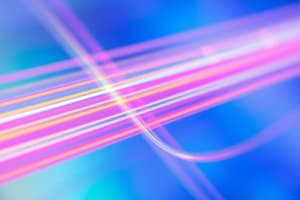Podcast
Questions and Answers
What is the primary function of a photodiode?
What is the primary function of a photodiode?
A photodiode converts light into an electrical current or voltage.
How does the surface area of a photodiode affect its response time?
How does the surface area of a photodiode affect its response time?
The response time of a photodiode decreases as its surface area increases.
What is the primary difference between a photodiode and an LED?
What is the primary difference between a photodiode and an LED?
A photodiode converts light to electricity, while an LED converts electricity to light.
What are the two types of current generated in a photodiode?
What are the two types of current generated in a photodiode?
Explain the construction of a junction photodiode.
Explain the construction of a junction photodiode.
Describe the operating principle of a junction photodiode.
Describe the operating principle of a junction photodiode.
What is the primary function of the intrinsic region in a PIN photodiode?
What is the primary function of the intrinsic region in a PIN photodiode?
How does the width of the depletion region affect the sensitivity of a photodiode?
How does the width of the depletion region affect the sensitivity of a photodiode?
List at least two different types of photodiodes mentioned in the text.
List at least two different types of photodiodes mentioned in the text.
Explain how the response time of a photodiode relates to its functionality.
Explain how the response time of a photodiode relates to its functionality.
Describe one way to improve the sensitivity of a photodiode.
Describe one way to improve the sensitivity of a photodiode.
What are the differences between a PIN photodiode and a standard p-n junction diode?
What are the differences between a PIN photodiode and a standard p-n junction diode?
What is the significance of the clear plastic medium in a junction photodiode?
What is the significance of the clear plastic medium in a junction photodiode?
List three applications of photodiodes in consumer electronics.
List three applications of photodiodes in consumer electronics.
What is a major advantage of PIN photodiodes compared to standard p-n junction diodes?
What is a major advantage of PIN photodiodes compared to standard p-n junction diodes?
Explain why minimizing dark current is important for photodiode sensitivity.
Explain why minimizing dark current is important for photodiode sensitivity.
What are the main advantages of photonic devices over electronic devices?
What are the main advantages of photonic devices over electronic devices?
Describe the principle of operation of a photodetector.
Describe the principle of operation of a photodetector.
Explain the concept of Solid State Lighting (SSL) and its key advantages over traditional incandescent lighting.
Explain the concept of Solid State Lighting (SSL) and its key advantages over traditional incandescent lighting.
List three essential requirements for an effective photodetector.
List three essential requirements for an effective photodetector.
What are some examples of applications where photonic technology is used?
What are some examples of applications where photonic technology is used?
Explain the relationship between photons in photonic devices and electrons in electronic devices.
Explain the relationship between photons in photonic devices and electrons in electronic devices.
Why are optical fibers essential for long-distance light transmission?
Why are optical fibers essential for long-distance light transmission?
What is the primary function of a solar cell, and how does it relate to photodetectors?
What is the primary function of a solar cell, and how does it relate to photodetectors?
Explain the purpose of the antireflection coating on the active area of a junction photodiode.
Explain the purpose of the antireflection coating on the active area of a junction photodiode.
Describe the process of creating the depletion region in a junction photodiode.
Describe the process of creating the depletion region in a junction photodiode.
What is the difference between the active area and the non-active area of a junction photodiode?
What is the difference between the active area and the non-active area of a junction photodiode?
Explain the role of minority carriers in the reverse saturation current of a junction photodiode.
Explain the role of minority carriers in the reverse saturation current of a junction photodiode.
How does the depletion region contribute to the collection of electron-hole pairs generated by incident light?
How does the depletion region contribute to the collection of electron-hole pairs generated by incident light?
Why is it important to connect a junction photodiode in reverse bias for it to function as a light detector?
Why is it important to connect a junction photodiode in reverse bias for it to function as a light detector?
Describe how the thickness of the non-active area affects the response and speed of a junction photodiode.
Describe how the thickness of the non-active area affects the response and speed of a junction photodiode.
Explain how adjusting the doping levels in the p-type and n-type regions can impact the characteristics of a junction photodiode.
Explain how adjusting the doping levels in the p-type and n-type regions can impact the characteristics of a junction photodiode.
Flashcards
Photodiode
Photodiode
A light detector that converts light into current or voltage.
LED
LED
A light-emitting diode that converts current into light.
PN Photodiode
PN Photodiode
A basic type of photodiode formed by p-type and n-type semiconductor materials.
Schottky Photodiode
Schottky Photodiode
Signup and view all the flashcards
PIN Photodiode
PIN Photodiode
Signup and view all the flashcards
Avalanche Photodiode
Avalanche Photodiode
Signup and view all the flashcards
Junction Photodiode
Junction Photodiode
Signup and view all the flashcards
Response Time of Photodiodes
Response Time of Photodiodes
Signup and view all the flashcards
Photonics
Photonics
Signup and view all the flashcards
Photonic Devices
Photonic Devices
Signup and view all the flashcards
Solid State Lighting (SSL)
Solid State Lighting (SSL)
Signup and view all the flashcards
Photo Detector
Photo Detector
Signup and view all the flashcards
Phototransistors
Phototransistors
Signup and view all the flashcards
Solar Cells
Solar Cells
Signup and view all the flashcards
Active region
Active region
Signup and view all the flashcards
Depletion region
Depletion region
Signup and view all the flashcards
Reverse saturation current
Reverse saturation current
Signup and view all the flashcards
Minority carriers
Minority carriers
Signup and view all the flashcards
Photon absorption
Photon absorption
Signup and view all the flashcards
Electron-hole pairs
Electron-hole pairs
Signup and view all the flashcards
Antireflection coating
Antireflection coating
Signup and view all the flashcards
Non-active area
Non-active area
Signup and view all the flashcards
Photo Carriers
Photo Carriers
Signup and view all the flashcards
Photocurrent
Photocurrent
Signup and view all the flashcards
Dark Current
Dark Current
Signup and view all the flashcards
Applications of Photodiodes
Applications of Photodiodes
Signup and view all the flashcards
Intrinsic Region
Intrinsic Region
Signup and view all the flashcards
Space Charge Region
Space Charge Region
Signup and view all the flashcards
Electron Excitation
Electron Excitation
Signup and view all the flashcards
Study Notes
4.7 Photonic Devices
- Photonics is the science of producing, controlling, and detecting photons.
- It combines optics and electronics, used in communication, data processing, transportation, medicine, and biotechnologies.
- Photonic devices transmit information faster over long distances than electronic devices because of light's high speed.
- Solid State Lighting (SSL) uses light-emitting diodes (LEDs), which are more efficient, reliable, and environmentally friendly than incandescent lighting.
- Devices like LEDs, photodiodes, solar cells, and optical fibers are part of photonic technology.
4.8 Photo Detector
- Photodetectors convert light signals into voltage or current.
- They are essential in optical communication links.
- Key requirements include high sensitivity, reliability, short response time, low bias voltage, and high electrical response.
- Examples of photo detectors are photodiodes and phototransistors.
- Solar cells also convert light to electrical energy, similar to photo detectors.
- LEDs are a different type of optical device.
4.8.1 Photo Diode
- Photodiodes convert light into current/voltage.
- Response time decreases with larger surface area.
- Similar to regular semiconductor diodes, but transparent enough for light to reach the key part.
- Different types based on construction and function: PN photodiodes, Schottky photodiodes, PIN photodiodes, and avalanche photodiodes.
4.8.2 Junction Photodiode
- A reverse-biased pn junction embedded in clear plastic.
- Light-induced current varies linearly with light intensity.
- Small size (about 1/10th of an inch).
- Constructed from p-type semiconductor (e.g., boron) and n-type semiconductor (e.g., phosphorus).
4.8.3 PIN Photodiode
- A photodiode with a lightly-doped, wide intrinsic semiconductor layer between p and n regions.
- Increases sensitivity by allowing more photons to be absorbed.
- Larger intrinsic region than a regular pn junction photodiode.
- Used in RF and microwave switches, microwave attenuators, fiber optic network cards, and to detect X-rays and gamma rays.
- Used for accurate light intensity measurements
Studying That Suits You
Use AI to generate personalized quizzes and flashcards to suit your learning preferences.





